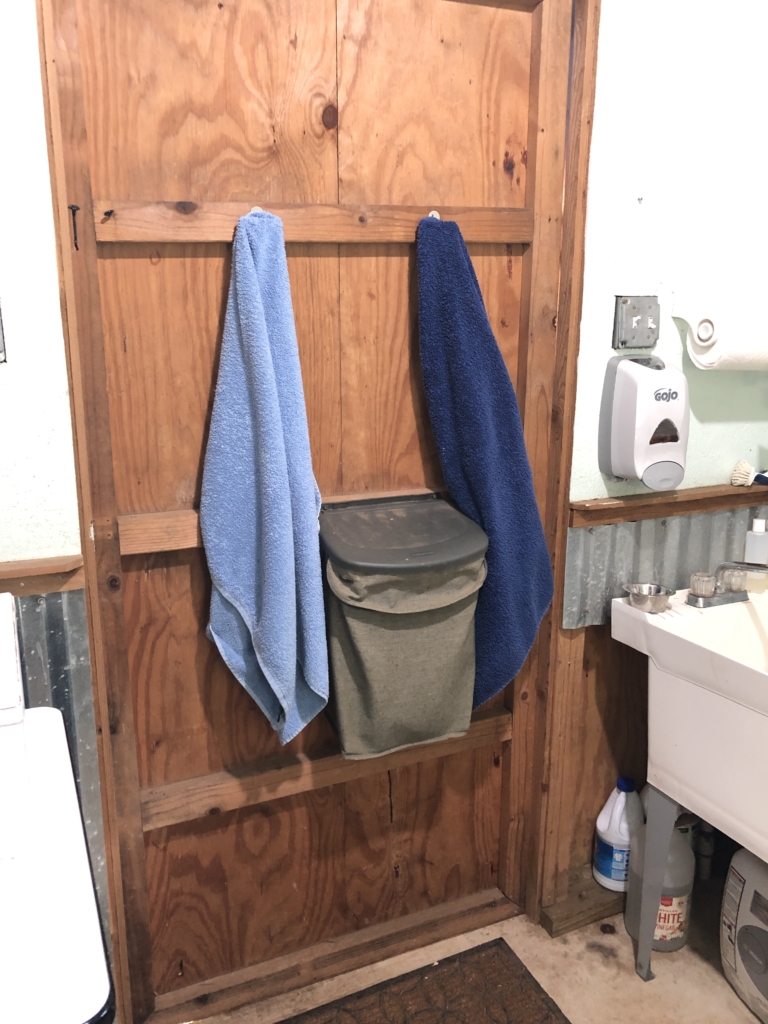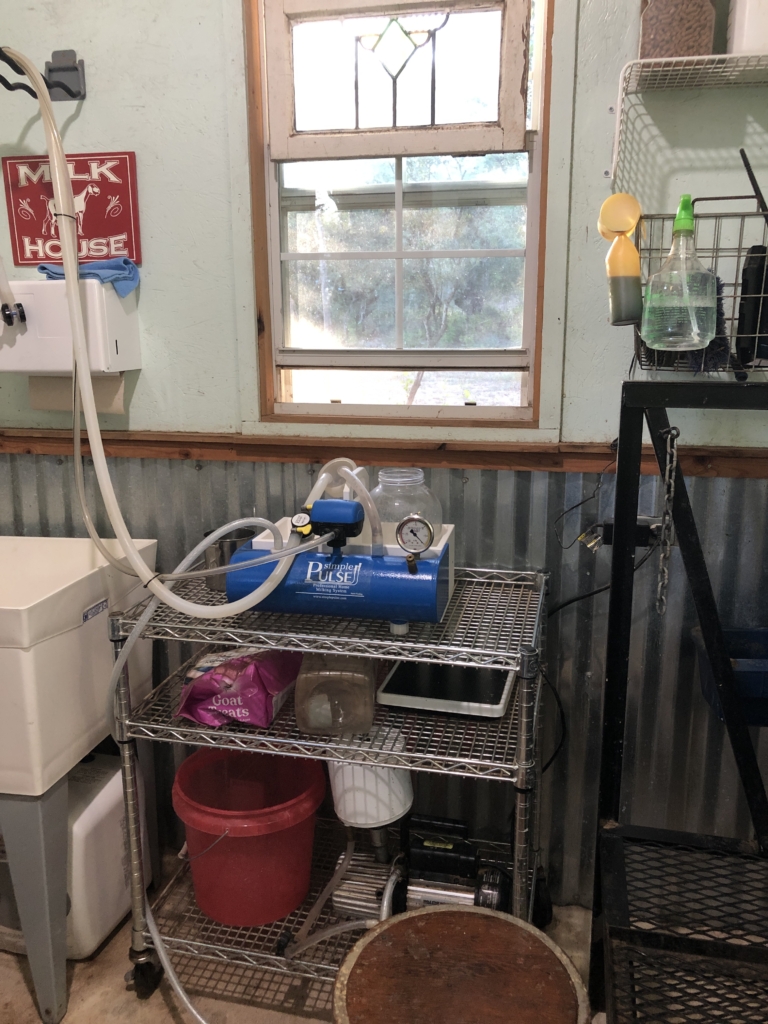
If you ask ten different dairy goat owners – what is your milking process? – you will likely get ten very different answers. Everyone has their own way of milking their goats. No one is right or wrong. Different products may be used. Different steps are taken. The ultimate goal of your milking process should be to successfully get the milk out of your goat and into a container with as little contamination as possible. So, what do you need to get started milking your goat? That answer depends on your setup, and if you will be hand milking or machine milking.
At the Rafter O, we have a Milk Room in our Doe Barn. We have a nice metal milk stand with a ramp. Our Simple Pulse Milk Machine is housed next to our milk stand. We have a sink with a small water heater. A cabinet stores non-temperature sensitive supplies. We also have a fan and a radio. In my opinion, must-haves as well! Take a look at the video tour of our milk room!
What You Will Need
Equipment
- Milk Stand
- Stainless Steel Buckets (Hand Milking)
- Strip Cup
- Stainless Steel Strainer with Filters (Hand Milking or No In-line Filter on Milk Machine)
- Simple Pulse Milk Machine
- Glass Jars with plastic lids (1/2 gallon wide mouth are best!)
Note: Caprine Supply sells a Basic Milking Kit that will get you started hand milking your goats. They also sell some of the other products I recommend.
Supplies

Spectrum High Detergency Chlorhexidine Udder Wash plus Skin Conditioners – formulated with chlorhexidine and high detergency to provide excellent cleaning with effective broad-spectrum germicidal activity. Provides quick and effective reduction of a wide range of bacteria. We dilute this following the directions and use it in a spray bottle as the first step in cleaning our goats’ udders.

Foam-N-Dip Teat Dip from Caprine Supply contains foaming agents, glycerine, lanolin, and 6% iodine. You can use this dip with a foaming dip cup or a regular teat dipper, both of which can be purchased at Caprine Supply.

Milk Check Teat Wipes are impregnated with allantoin, glycerin, and lactic acid. These teat wipes offer superior cleaning properties while preventing teat chapping and reducing cross-contamination. They contain a natural food-grade approved lactic acid solution, Biocell, that contained an effective mixture of ingredients to provide exceptional cleaning and skin conditioning. Wipes measure 7″ x 8″ and are available in reusable pails of 700 sheets or in refill pouches. We get ours from Caprine Supply.

UPDATE: We recently changed our pre-milking cleansing protocol and started using Effercept SG. Nothing compares to fast-acting EfferCept teat dip tablets for powerful killing and cleaning; even in the presence of dirt, manure, and other organic matter. Just dissolve the tablets in water and use the products pre/post teat dip, spray, foam, or scrub.
EfferCept SG is a teat dip for powerful killing, cleaning combined in one effervescent tablet. Enriched with SoftGuard “SG” conditioner, EfferCept SG penetrates to help protect and soften teats, skin, and udders. EfferCept SG quickly kills 99.999% of E. coli and Staph. aureus plus a broad spectrum of other mastitis-causing organisms. The effervescent tablets dissolve in hard or soft potable water. Dissolve 2 tablets per gallon of water.

Paper Towels are a must in your milking area! We have the brown paper dairy towels from Caprine Supply, and we have regular paper towels. I prefer the “Select A Size” rolls where you can tear off a half sheet.

Fight Bac is a must-have in your barn not only for milking, but it has a TON of other uses! It contains active ingredients Chlorhexidine and Glycerine to protect against infection and maintain excellent skin condition. The spray pattern clears residual milk from the teat orifice and provides effective coverage. Fight Bac chills the teat, enhancing closure of the teat orifice. At the Rafter O, we also use Fight Bac on newborn navels, cuts & wounds, and to clean skin prior to injections. Fight Bac is sold online. We get ours at Caprine Supply.

Udder Cream is needed if your goats’ teats or udders are chapped and dry. We use this more often when dams are nursing kids because the teats take a beating from those sharp little kid teeth. There are many varieties of udder cream to choose from. We’ve used Chap-Guard Plus Udder Cream, Bag Balm, and Dynamint Mint Udder Cream. All of these have pretty much the same ingredients with the exception of the mint creams – these would be used when you have a goat with a congested udder.

Dairy Utensil Cleaner is a high-foaming, hard-working, all-purpose detergent for the manual cleaning of dairy equipment. We use a few drops of this in cold water for the first step of cleaning our Simple Pulse, and we also use it to clean the glass jars that don’t fit in the dishwasher. I’ve had the same one-gallon jug for about 5 years, and it is half empty. A little goes a long way! You can purchase this at Amazon.

Bleach is a must-have for disinfecting and sanitizing your milking equipment. You will want to use Regular Bleach. Stay away from the low-splash, scented, etc. Just plain jane!

Cleaning Vinegar is used as an acid wash to clean your milking equipment from milk protein build up. Any brand will do.
Milking Steps
- Feed your goat on the milk stand and lock your goat into the stanchion.
- Spray udder well with Diluted Udder Wash (or Effercept) in a spray bottle.
- Wash hands in the sink with soap and warm water.
- Use paper towels to dry hands and wipe udder.
- Dip teats with Iodine Teat Dip (or Effercept).
- Use two Teat Wipes – wipe first one all over udder – wipe second one on each teat reversing sides.
- Use another paper towel to dry your hands completely and dry teats.
- Strip 2-3 squirts of milk from each teat into strip cup.
- Begin hand-milking into bucket OR hook up milk machine inflators to teats.
- If machine milking, hand-milk out last few squirts to empty udder.
- Spray each teat with Fight Bac 1/2 inch from the teat orifice.
- Give your girl a treat! All done!

I got the milk…now what?
Now you need to get the milk cooled down as quickly as possible. Get your milk into your glass jars. If you hand-milked or did not have an in-line filter on your machine, you will need to filter your milk as you pour it into the jars. We recently switched to the All-in-One Jar from Simple Pulse that filters the milk as it comes into the jar. You can either put your milk in an ice bath with the lid slightly ajar, or you can put it in the freezer for an hour or so before moving it into the refrigerator. At the Rafter O, we just pour our milk from the all-in-one jar into 1/2 gallon jars. These go into the freezer for one hour – I use my AppleWatch to set a timer! Don’t forget it! If it freezes solid, the jars will crack. Ask me how I know this! I find it very helpful to label the top of each jar with the date. Dissolvable food storage labels work perfectly for this function! We purchased these from Amazon – Blank Dissolvable Food Storage Labels.
Bonus: Cleaning Your Simple Pulse
We closely follow the Simple Pulse instructions for cleaning our machine. We use 4 products for cleaning our system:
1. Dairy Utensil Cleaner
2. Bleach
3. Cleaning Vinegar
4. Simple Pulse Cable Brush Kit
We use a 2.5 gallon bucket for our cleaning process. We fill up the bucket with cold or lukewarm water with a small squirt of the Dairy Utensil Cleaner. You do not want your first step to be hot water as that will set the milk proteins into your hose. Attach your hoses to your cleaning jar, turn on your pump, and run the soapy water through your hoses. We go ahead and fill up the entire cleaning jar with the soapy water, and then turn off the pump, and dump out the cleaning jar to get ready for the next step.
Dump out your soap water from the bucket, rinse, and fill with hot water and bleach (approx 2 tsp per 2 gallons of water). You want this water to be very hot as this is your sanitizing step. One thing to note about the bleach is that the little bit that may be left in your lines after sanitizing becomes inactive once organic matter touches it so you will not have any bleach in your milk. Repeat the same steps above using the hot bleach water. Use the hot water bleach to rinse the cleaning jar lid.
Once a week, we also do an acid rinse using the white vinegar (approx 1/2 cup per 1.5 gallons of hot water).
Once a week, we also run a cable brush kit through our milk lines as we find that it helps keep our lines extremely clean. We also use the inflation brush to clean the inflators after they are taken apart. We then soak the inflations and hose parts in hot bleach water.
After our lines are sanitized, we hang them to dry next to our machine. The hoses and inflations are covered with a towel and the pulsator and jar box are covered with a towel as well to keep the dust off.
Our milking jars are cleaned in the house with the Dairy Utensil Cleaner and hot bleach water and allowed to air dry.
Bonus: Photo Tour of Milk Room

The Rafter O Milk Room is a 10ft x 10ft room. It has concrete floors with a drain in the center of the room and makes for easy cleaning and sanitation. Our milk stand has a ramp that can be folded down if needed.

This corner houses our utility sink. We recently added a Bosch Electric Mini-Tank Water Heater Tronic 3000 T 4-Gallon which saves us from hauling hot water from the house.

On the entry door to the milk room, we have two hooks for hanging up the towels after we uncover the milk machine and hoses. In the middle of the door, we are using a Rubbermaid Hidden Recycler for a trash receptacle. This is great because it frees up floor space!

This Utility Cart on wheels is perfect to house our Simple Pulse machine. The pump and oil mist eliminator is on the bottom shelf and the pulsator on the top shelf.

Our milk stand is made of metal and is easily cleaned. We vacuum up hairs and other debris, and then we use Simple Green and a deck brush to scrub it down. Before each milking season, we apply a fresh coat of black Rustoleum spray paint.
A basket mounted to the wall stores our Bosch AM/FM Radio, Udder Wash Spray, Iodine Teat Dip, and miscellaneous grooming supplies.

This door leads into the alley of the doe barn. We use this small Shop-Vac to keep the milk room nice and tidy!

We live in Texas, and this fan is a MUST HAVE! It is a Hurricane HGC736503 Wall Mount Fan 16 Inch. It has three speeds and can be set to oscillate…only an air conditioner would be better!

This corner houses all of our everyday items that are not sensitive to extreme temperatures. Note the Udder Cream resting on top of the Milk Check Teat Wipe bucket. Placing something on top of the wipe hole helps keep them from drying out.
Thank you for checking out our Blog! Please let us know if you have any questions!






